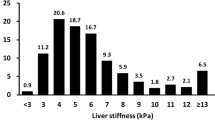Abstract
Background and Aims
The patients with end stage renal disease (ESRD) are at greater risk of acquiring chronic hepatitis B or C and subsequently development of liver disease. The aim of the study was to assess liver fibrosis by transient elastography (TE) and look for factors associated with change in liver stiffness measurement (LSM) with one session of hemodialysis (HD).
Methods
Consecutive ESRD patients on maintenance hemodialysis (MHD) with suspected liver disease were enrolled. They underwent LSM by TE before and after one session of HD. Bioelectric impedance analysis was done to evaluate the volume status at the time of TE.
Results
Sixty-eight patients with mean age of 40 ± 14 years were included. There was a significant reduction in LSM after HD (18.5 [95% CI 14.8–23.1] vs. 11.2 [95% CI 8.8–13.7] kPa, p < 0.001), with a mean LSM reduction of 7.2 [95% CI 5.25–9.19] kPa. On stratification in two groups by net ultrafiltration during HD (> or < 2.5 liters [L]), change in LSM was substantially higher in patients when total fluid removed was > 2.5 L (8.6 [95% CI 5.7–11.5] vs. 5.1 [95% CI 2.9–7.5], p = 0.05). In 18 patients who underwent liver biopsy, LSM after HD performed better at detecting significant fibrosis, with area under receiver operating characteristics curve 0.71 [95% CI 0.46–0.97], versus 0.64 [95% CI 0.38–0.90], respectively. An LSM value of 12.2 kPa after HD was 71% sensitive and 74% specific for detection of significant fibrosis (≥ F2), while values less than 9 kPa ruled out significant fibrosis with a sensitivity and specificity of 37 and 100%, respectively.
Conclusion
LSM by TE decreases significantly after HD in patients with ESRD on long-term MHD. Hence, TE should be done after HD for accurate assessment of liver fibrosis.




Similar content being viewed by others
References
Chacko EC, Surrun SK, Mubarack Sani TP, Pappachan JM. Chronic viral hepatitis and chronic kidney disease. Postgrad Med J. 2010;86:486–492.
Rockey DC, Caldwell SH, Goodman ZD, Nelson RC, Smith AD, American Association for the Study of Liver Diseases. Liver biopsy. Hepatology. 2009;49:1017–1044.
Castera L, Forns X, Alberti A. Non-invasive evaluation of liver fibrosis using transient elastography. J Hepatol. 2008;48:835–847.
Sandrin L, Fourquet B, Hasquenoph JM, et al. Transient elastography: a new non-invasive method for assessment of hepatic fibrosis. Ultrasound Med Biol. 2003;29:1705–1713.
Nguyen-Khac E, Capron D. Noninvasive diagnosis of liver fibrosis by ultrasonic transient elastography (Fibroscan). Eur J Gastroenterol Hepatol. 2006;18:1321–1325.
Roulot D, Czernichow S, Le Clesiau H, Costes JL, Vergnaud AC, Beaugrand M. Liver stiffness values in apparently healthy subjects: influence of gender and metabolic syndrome. J Hepatol. 2008;48:606–613.
Castera L, Pinzani M. Non-invasive assessment of liver fibrosis: are we ready? Lancet. 2010;375:1419–1420.
Talwalkar JA, Kurtz DM, Schoenleber SJ, West CP, Montori VM. Ultrasound-based transient elastography for the detection of hepatic fibrosis: systematic review and meta-analysis. Clin Gastroenterol Hepatol. 2007;5:1214–1220.
Castera L, Pinzani M. Biopsy and non-invasive methods for the diagnosis of liver fibrosis: does it take two to tango? Gut. 2010;59:861–866.
Millonig G, Reimann FM, Friedrich S, et al. Extrahepatic cholestasis increases liver stiffness (FibroScan) irrespective of fibrosis. Hepatology. 2008;48:1718–1723.
Coco B, Oliveri F, Maina AM, et al. Transient elastography: a new surrogate marker of liver fibrosis influenced by major changes of transaminases. J Viral Hepat. 2007;14:360–369.
Arena U, Vizzutti F, Corti G, et al. Acute viral hepatitis increases liver stiffness values measured by transient elastography. Hepatology. 2008;47:380–384.
Trabut JB, Thepot V, Nalpas B, et al. Rapid decline of liver stiffness following alcohol withdrawal in heavy drinkers. Alcohol Clin Exp Res. 2012;36:1407–1411.
Millonig G, Friedrich S, Adolf S, et al. Liver stiffness is directly influenced by central venous pressure. J Hepatol. 2010;52:206–210.
Koch A, Horn A, Duckers H, et al. Increased liver stiffness denotes hepatic dysfunction and mortality risk in critically ill non-cirrhotic patients at a medical ICU. Crit Care. 2011;15:R266.
Liu CH, Liang CC, Huang KW, et al. Transient elastography to assess hepatic fibrosis in hemodialysis chronic hepatitis C patients. Clin J Am Soc Nephrol. 2011;6:1057–1065.
Castera L, Vergniol J, Foucher J, et al. Prospective comparison of transient elastography, Fibrotest, APRI, and liver biopsy for the assessment of fibrosis in chronic hepatitis C. Gastroenterology. 2005;128:343–350.
Kyle UG, Bosaeus I, De Lorenzo AD, et al. Composition of the ESPEN working group. Bioelectrical impedance analysis–part I: review of principles and methods. Clin Nutr. 2004;23:1226–1243.
Del Poggio P, Colombo S. Is transient elastography a useful tool for screening liver disease? World J Gastroenterol. 2009;15:1409–1414.
Ziol M, Handra-Luca A, Kettaneh A, et al. Noninvasive assessment of liver fibrosis by measurement of stiffness in patients with chronic hepatitis C. Hepatology. 2005;41:48–54.
Giallourakis CC, Rosenberg PM, Friedman LS. The liver in heart failure. Clin Liver Dis. 2002;6:947–967.
Colli A, Pozzoni P, Berzuini A, et al. Decompensated chronic heart failure: increased liver stiffness measured by means of transient elastography. Radiology. 2010;257:872–878.
Kellner P, Anadol E, Huneburg R, et al. The effect of hemodialysis on liver stiffness measurement: a single-center series. Gastroenterol Hepatol. 2013;25:368–372.
Khunpakdee N, Jayanama K, Kaewdoung P, et al. Transient elastography in end-stage renal disease patients on hemodialysis: the effect of net fluid withdrawal. Blood Purif. 2015;40:256–259.
Author information
Authors and Affiliations
Corresponding author
Ethics declarations
Conflict of interest
The authors who have taken part in this study declared that they do not have anything to disclose regarding funding or conflict of interest with respect to this manuscript.
Rights and permissions
About this article
Cite this article
Taneja, S., Borkakoty, A., Rathi, S. et al. Assessment of Liver Fibrosis by Transient Elastography Should Be Done After Hemodialysis in End Stage Renal Disease Patients with Liver Disease. Dig Dis Sci 62, 3186–3192 (2017). https://doi.org/10.1007/s10620-017-4777-6
Received:
Accepted:
Published:
Issue Date:
DOI: https://doi.org/10.1007/s10620-017-4777-6




